

Modeling a Cache Coherence Protocol with the Guarded Action Language Quentin Meunier, Yann Thierry-Mieg, Emmanuelle Encrenaz Laboratoire d’Informatique de Paris 6, Sorbonne Université, Paris.
The TeraScale Architecture TSAR Hardware architecture designed to scale to up to 1024 core Hardware enabled cache coherence, logically a single address space, NUCA characteristics
Architecture Asynchronous process communicating over unidirectional shared channels Separate channels for direct and coherence transactions
Accessing memory Five independent networks in V5, six in V4 Channel Source Dest. Messages Adr. Id PL1DTREQ Proc L1 DT_RD 1 / DT_WR L1PDTACK L1 Proc ACK_DT_RD 1 / ACK_DT_WR L1MCDTREQ L1 L2 RD 1 1 WR MCL1DTACK L2 L1 ACK_RD 1 1 ACK_WR
Distributed Hybrid Cache Coherence Protocol DHCCP L2 cache maintains a directory of L1 copies of the data Directory is physically distributed Inclusive : any data in a L1 is necessarily in L2 Write through : L2 version is always the latest Direct transactions Read, Write, Load-Linked/Store Conditional LL/SC, Compare and Swap CAS Coherence transactions Update or evince L2 => update/invalidate all copies, wait for ACK Multicast update if few copies Broadcast an invalidate request if above the DHCCP threshold Count the responses in both cases Hybrid Multicast/Broadcast policy based on DHCCP threshold
Design issues Separate Networks, Asynchronous behaviors … Errors are easy to make, hard to detect by simulation and testing This V4 example deadlocks …
Applying model-checking Could formal verification help gain more confidence in the design ? Challenges : Abstract from the real system faithfully Wide configuration space : Number of cores/threads, Number of addresses, DHCCP threshold Several versions of the protocol (V4 and V5) Smallest complete behavior : 3 cores, 2 addresses, threshold=2 Observe both broadcast and multicast Goal is automatic verification => model-checking Counter-example traces help debug
Verifying the protocol Extract manually from the code + specifications Communicating automata over channels Components : Processor, L1 cache, L2 cache, Memory
Building a model with Promela/SPIN Two Master 1 students : M. Najem 2011, A. Mansour 2012 Build the Promela model Formalisms of Communicating process matches the need :: L1MCCUREQ ? m.type, eval(line_addr), m.cache_id -> do // Delete the cache id that did the request from the list of copies :: (cpt == CACHE_TH) -> break ; :: ((cpt < CACHE_TH) && (v_c_id[cpt] == VALID) && (c_id[cpt] == m.cache_id)) -> v_c_id[cpt] = INVALID; n_copies = n_copies - 1; break; :: else -> cpt = cpt + 1; od;
Results with SPIN Initial models are too detailed Observation automata are encoded into the model to check it’s properties Cumbersome/intrusive observation mechanism for channels Incremental modeling of each component + verification in isolation is possible Parametric features are good Simulator and traces as sequence diagrams are very useful Two versions of the protocol modeled More aggressive data abstraction in the second version Some extensions explored e.g. LL/SC Full verification only possible for very small configurations Unable to obtain full formal verification POR reductions limited by heavy channel usage
Modeling and Verification in DiViNe Master 2 student: Z. Gharbi DiViNe is both a language and a model checker Several versions, now focused on code verification BEEM benchmark (2007) -> LTSmin, ITS-tools , Divine… Similar in concept, but much more basic than Promela Parametric constructions with m4 preprocessor Channel support proved inadequate : use global variables Properties encoded as LTL with fairness Only Divine itself supports the keyword ! Able to reproduce the deadlock + patch Still unable to model-check truly relevant configurations Integration of other tools a bit limited
Modeling in Guarded Action Language Master 2 student : D. Zhao GAL is an intermediate pivot language for concurrent semantics Integers, and fixed size arrays of integers Parametric and compositional features Initially supported by a powerful SDD engine (lots of MCC medals) Additional support now for LTSMin+POR Some SMT based verification SMT LTSmin
13 A simple GAL gal simple { int a = 5 ; int b = - 2 ; array [3] tab = (0, 8, - 6); transition t1 [ a < tab [2] ] { a = (b + 3) * 255; Sequential b = a * tab [1]; Nondetermism, self ."act"; semantics synchronization self ."act"; } transition t2 [ true ] label "act" { tab [0] = (tab [0] - 1) | ((tab [0] == 255) * 255); } Indexes, bitwise operators… transition t3 [ true ] label "act" { } } property goal [ reachable ] : tab[0] == 8; Embedded properties
Composite and Parametric features Instantiation of components Parameters over finite range For loop Parametric transitions and labels
Modeling with GAL Explicit models of channels T wo variants depending on data Automata directly expressed with a « state » variable Labels used to describe channel operations Description is hierarchical and parametric Composite description makes use of arrays of cores+L1; arrays of L2 … Fine control over atomicity semantics Fusion of REQ/ACK in some scenarios No simulator « Unit » verification used to debug model behavior
« Unit verifying »
Verification with ITS-Tools Performance sensitive to the description Decomposition/recomposition heuristics still WIP With appropriate descriptions and hierarchy, full verification is possible First full result on the minimal target configuration 3/2/2 Scale up is still limited, largest configurations 3/3/3, 4/2/2, 6/1/2… even with 24h and sizeable RAM No deadlocks reported in any configuration Full LTL with fairness results still incomplete Data abstraction prevents verification of memory model consistency in this version
Conclusion Formal modeling/verification is still a costly proposition Manual abstraction is not very trustworthy , but… Modeling all the implementation details swamps the model Protocol issues are not necessarily in the routing/transport details Different solution engines/tools have different strengths and weaknesses Lack of a more uniform description language, well supported by several tools (e.g. SMT equivalent) Model-checking was part of the result A lot of confidence and understanding was also gained purely by building the formal descriptions themselves and debugging them
Recommend
More recommend